“an owner representative intends to represent the owner’s best interests: isn’t that supposed to be the AIA architect’s responsibility?
The often adversarial relationship between American architects and residential contractors has its roots as far back as the Civil War. As the following recalls, it was somewhat a question of markets-share, wherein architects were glomming up design work hitherto carried out by builders, who considered an architect a sort of fifth-wheel. Thus, builders soon began calling themselves “architects,” and from that era, perhaps, the advent of design-build. The next manifestation is the owner representative.
From Colonial times until around 1850, clients and builders designed almost all houses in America. Architects had to create their profession against the odds. They had to persuade their countrymen that important distinctions existed between the art of designing and the act of building. Once architects had made some headway with their case, many builders without formal training began describing themselves as architects, too. Doubtless many more declared, as Thompson[1] did, that trained architects were merely superfluous beings.
Between 1830 and the Civil War, architects published scores of pattern and style books. At one point or another, most of those volumes argue that an architect offers the client protection from the builder. The case is often founded on social class, the architect being the client’s ally by virtue of education and breeding. The argument plays upon the suspiciousness {sic} of clients about builders, a wariness that seems to have been around for so long that it probably deserves to be called natural.
“There is a glaring want of truthfulness sometimes practiced in this country by ignorant builders, that deserves condemnation at all times,” wrote Andrew Jackson Downing, in 1850, in one of his very popular style books. In this case, “truthfulness” meant right-minded aesthetic sensibility.
Competing with builders for the patronage of people with the money to build, in an age of emerging specialization, architects staked a claim on taste. Pattern and style book writers defined taste in many ways, but ultimately it seems to have been simply something a trained architect had and a builder didn’t. And while clients usually were described as having taste, most needed architects to find their way to it. An architect could protect clients from themselves as well as ignorant builders.[2]
The above text illustrates two perceptions held by American architects of builders, namely, a presumed class superiority assumed by architects over builders which dictated a natural alliance of the architect with the client, and an avowed distrust of builders by architects, which they impressed upon their clients. This was a telling statement, for remnants of this adversarial relationship still exist today. The “natural” suspicion of builders by clients is still pervasive. Even class distinction still influences owners’ tacit perceptions builders and their so called betters. As a result, architects have happily assumed the position of client’s advocate.
Although the architect is the natural advocate of the owner – as it is so stated in the standard AIA agreement between architect and owner, there is often no one representing the owner to the architect – an owner-representative. Judging from the volume of litigation between owners and their architects, it is clear that most stakeholders have no owner representative proper, and see no need for one. This is even so when a contractor is recommended by the architect, to the owner. When such relationships exist, conflicts of interest are not unusual.
An owner representative may begin in the design phase, or more typically with the build-out, depending on how involved the owner wants to be in the process. Once the build-out starts, most of his liaisons will be with the contractor, as he is seldom asked to manage the design team. Yet, the design team often targets final details in the build-out stage, and it is typically the owner himself who minds the design team – an occupation he is typically ill-equipped, or suited to. This is a common oversight owners make when planning their projects. If the project stalls in the design phase, there is no oversight to detect it.
Most owners will build only one-house in their lifetime, whereas an owner representative must have years’ experience. A solid owner representative provides an excellent return of investment because he typically spends a minimal amount of time on-task – such as attending design, progress, or job meetings, and those times are always mission critical. Since he is already the owner’s advocate, why not extend his oversight of project development to include the design team to monitor the architect’s performance?
I expect some architects would advise against, and are generally intolerant of, an owner-representative, as they aren’t used to having to answer to anyone but the owner, and likely suspect a typical owner-representative does not have enough training to exert control of them. Indeed this is often the case with inexperienced agents, who are as prolific as charlatan construction managers. Thus, there is not a cohesive industry of owner’s representatives there for the taking, as demand is not exactly universal. Just as you would vet your architect and builder, it is ever important to review a prospective owner representative’s qualifications before hiring one.









